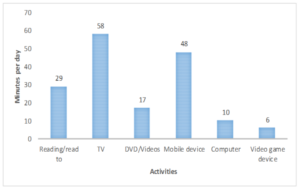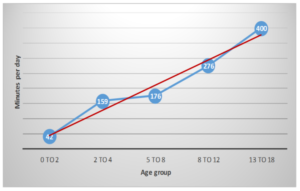 By Abel J. Koury, Ph.D.
By Abel J. Koury, Ph.D.
In kindergarten, my teacher told my parents that I was a “fish out of water”, disrupting the other children at naptime. I couldn’t help myself—the idea of sleeping when I could be playing seemed odd (funny how things trend in the opposite direction as I age). My most favorite part of the day was recess—the enchanted hour where I could run, explore, and hang with my friends. As an adult, I still have trouble sitting down for extended periods of time. In fact, most adults I know can’t sit at a desk for 8 hours a day without a break. We’re just not built to sit all day, much less indoors, and neither are children. Yet, as of 2016, only 64.8% of elementary schools required daily recess, and the majority of these schools required less than 30 minutes of recess. Given that children literally have the metabolism and energy levels of well-trained endurance athletes, asking them to sit still all day is against their very nature. Evidence suggests that it is also less effective for learning—as it turns out, recess is as important as math and reading.
You’ve gotta fight for your right to…recess?
Just recently, parents in Florida fought to have their elementary school children guaranteed 20 minutes of recess each day. In 2016, Rhode Island did the same for their K-6th grade students. Students in Louisiana, on the other hand, were not as lucky; a bill to require 30 minutes of recess for students K-8 was just rejected this past May. The exact amount of time children spend engaged in recess is hard to find, and most data on this topic are from the No Child Left Behind (NCLB) era. Although dated at this point, past research suggests that time spent on recess and physical activity decreased as a result of No Child Left Behind (NCLB). With NCLB replaced by Every Students Succeeds Act (ESSA), if and how recess is making a comeback is still up for examination. One thing seems clear, though: physical activity throughout the day—or lack thereof-does not appear to be a high priority for states to regulate or track. This is likely why there isn’t available data on quantity of recess at the state level. According to recent estimates, only 8 states require elementary schools to provide recess each day. Just because states don’t explicitly require recess doesn’t necessarily mean that children are not getting recess—however, a 2012 study showed that when states require 150 minutes of physical activity per week or 20 minutes of recess per day, the odds of schools meeting those requirements increased significantly. It turns out, requiring recess makes it more likely to happen.
Ohio does not require daily recess in elementary school and although there are state standards for physical education, these are offered as a suggestion only. School districts ultimately decide how much (and what kind of) activity to provide. Although Ohio does require schools to provide physical education to students across grade-levels, there is no required minimum for physical activity. Again, getting school-level data on recess is challenging, making it difficult to ascertain how much or how little physical activity Ohio students are getting throughout the day. It’s also not the type of data provided to parents or the public through annual Ohio School Report Cards.
For students with less access to parks, playgrounds, or community spaces for play after school hours, the stakes are even higher: A study by the Robert Wood Johnson Foundation showed that over 40% of children get the majority of their total physical activity at recess.
While physical activity is going down, weight is going up
The most recent data show that the national childhood obesity rate is 18.5%. Alarmingly, before children even enter kindergarten, 14% are already considered obese. In Ohio, a third of children from 10-17 years of age are overweight/obese, ranking Ohio in the top 20 in terms of childhood obesity. For children ages 2-4 enrolled in the Special Supplemental Nutrition Program for Women, Infants, and Children (WIC), the obesity rate is already more than 1 in 10.
Importantly, some children are more likely to be obese than others. Children from lower income homes as well as African American and Latino children are more likely to be obese compared to more affluent peers and White and Asian children. Some of this can be attributed to having less access to fresh, healthy foods and safe places to be physically active such as parks and recreation centers. By crossing the data on child obesity with recess, we also see that Black and Brown children (as well as lower-income children) are less likely to receive recess and more likely to be obese/overweight. Is it possible that daily recess can quell childhood obesity for our most vulnerable children?
Although dated, research from the early 2000’s suggested that roughly 80% of randomly selected children on a randomly selected school day in 2002 received recess; however, only 61% of African American students had recess compared to 85% of non-Hispanic White children. Further, you’re chance of getting recess is roughly 30% more likely if you live above the poverty line compared to below it. Even in schools allowing recess, ~50% of children miss out because of misbehavior. African American and Hispanic students are less likely to have recess in general; in schools where they get recess, they are more likely to have recess taken away for misbehavior. Thus, even these numbers are potentially upwardly biased.
And then there’s the whole “screens” thing
In 2017, 98% of homes had at least one mobile device, up from 75% in 2013. This means that having a mobile device is now as common as having a television set in the home. With the accessibility of both television sets and mobile devices, even the youngest children (under age 2) spend an average of 42 minutes with screens each day. The amount of total screen time more than quadruples for children between 5 and 8 years of age to 2 hours and 56 minutes. Considering that children between 5 and 8 years of age spent around half an hour each day reading/being read to and an hour and two minutes on mobile devices, the average child is spending roughly 32 more minutes a day engaged with mobile devices compared to literary activities[1].
[1] Children spent about 29 minutes reading; of these, only three minutes were on an electronic device. As such, the majority of the time children are spending engaged with mobile screens is not spent reading.
 Figure 1. Minutes per day spent on various activities for children ages 0 to 8
Figure 1. Minutes per day spent on various activities for children ages 0 to 8
Source: CommonSenseMedia.org
Initially, an extra half an hour each day may seem minimal, but consider that children will have experienced 11,680 more minutes (almost 195 hours) of mobile device time compared to book-reading after a year. If the average school day is 6.5 hours long, the amount of time spent on mobile devices compared to book-reading is the equivalent of roughly 30 days of school.
Time spent with screen media appears to increase linearly as children age. By the time children are 13 years of age, almost three hours of their day is spent on smartphones.
 Figure 2. Total minutes per day with screen media by age group
Figure 2. Total minutes per day with screen media by age group
Source: CommonSenseMedia.org
Putting it all together
Childobesity180.org, an initiative from Tufts University, suggests that childhood obesity is related to a complex web of factors, two of which are a decrease in recess and physical education at school and an increase in screen time.
So what can be done? For starters, Ohio might consider joining other states that require daily recess for students. The Centers for Disease Control and Prevention (CDC) recommends that children get at least an hour of physical activity each day. Having some of this built into the school day is beneficial for all children, but it is especially beneficial for children who are less able to get exercise after the school day ends. Additionally, get to know the astronomical benefits of recess and distribute it to your stakeholders. If necessary, fight for your right to recess. Don’t stop there—knowing that there are benefits to recess on average isn’t the same as collecting data and assessing the effects at your own school. Who gets recess each day? How much recess? Are you seeing improved behavior or achievement related to increases or decreases in daily physical activity? If we don’t collect it, we can’t track it; if we can’t track it, we can’t assess it; if we can’t assess it, we can’t improve it. Finally, capitalize on the fact that children are using screens. With 95% of children in homes with a smartphone, we can get creative. Is it possible to create workout videos with students in the classroom that can be uploaded to a shared classroom account? Parents can create their own workout videos or use the ones from the classroom to exercise with their children.
Do you remember The three Rs: Reading, wRiting, and aRithmetic? Some say that we should move to a new four R’s (rigor, relationships, relevance, and results). Regardless, one of the R’s should be recess.
